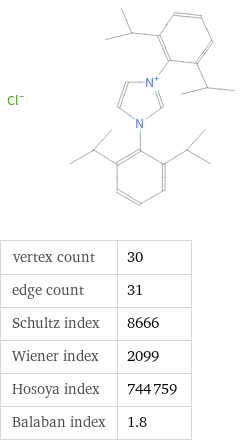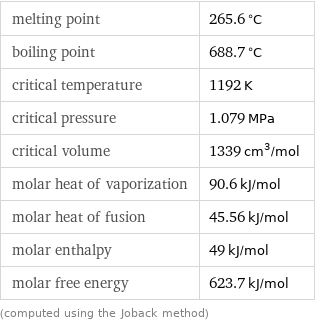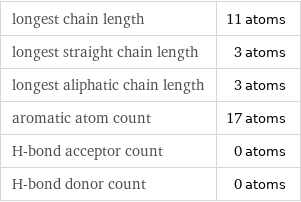Input interpretation

1, 3-bis(2, 6-diisopropylphenyl)imidazolium chloride
Basic properties
![molar mass | 425.1 g/mol formula | C_27H_37ClN_2 empirical formula | Cl_C_27N_2H_37 SMILES identifier | CC(C)C1=C(C(=CC=C1)C(C)C)[N+]2=CN(C=C2)C3=C(C=CC=C3C(C)C)C(C)C.[Cl-] InChI identifier | InChI=1/C27H37N2.ClH/c1-18(2)22-11-9-12-23(19(3)4)26(22)28-15-16-29(17-28)27-24(20(5)6)13-10-14-25(27)21(7)8;/h9-21H, 1-8H3;1H/q+1;/p-1/fC27H37N2.Cl/h;1h/qm;-1 InChI key | AVJBQMXODCVJCJ-UHFFFAOYSA-M](../image_source/03105395b0c223c8a43b736ba3e362ea.png)
molar mass | 425.1 g/mol formula | C_27H_37ClN_2 empirical formula | Cl_C_27N_2H_37 SMILES identifier | CC(C)C1=C(C(=CC=C1)C(C)C)[N+]2=CN(C=C2)C3=C(C=CC=C3C(C)C)C(C)C.[Cl-] InChI identifier | InChI=1/C27H37N2.ClH/c1-18(2)22-11-9-12-23(19(3)4)26(22)28-15-16-29(17-28)27-24(20(5)6)13-10-14-25(27)21(7)8;/h9-21H, 1-8H3;1H/q+1;/p-1/fC27H37N2.Cl/h;1h/qm;-1 InChI key | AVJBQMXODCVJCJ-UHFFFAOYSA-M
Structure diagram

vertex count | 30 edge count | 31 Schultz index | 8666 Wiener index | 2099 Hosoya index | 744759 Balaban index | 1.8
Estimated thermodynamic properties

melting point | 265.6 °C boiling point | 688.7 °C critical temperature | 1192 K critical pressure | 1.079 MPa critical volume | 1339 cm^3/mol molar heat of vaporization | 90.6 kJ/mol molar heat of fusion | 45.56 kJ/mol molar enthalpy | 49 kJ/mol molar free energy | 623.7 kJ/mol (computed using the Joback method)
Units

Quantitative molecular descriptors

longest chain length | 11 atoms longest straight chain length | 3 atoms longest aliphatic chain length | 3 atoms aromatic atom count | 17 atoms H-bond acceptor count | 0 atoms H-bond donor count | 0 atoms
Elemental composition

Find the elemental composition for 1, 3-bis(2, 6-diisopropylphenyl)imidazolium chloride in terms of the atom and mass percents: atom percent = N_i/N_atoms × 100% mass percent = (N_im_i)/m × 100% Plan: • Write the chemical formula and gather atomic masses from the periodic table. • Determine values for N_i, m_i, N_atoms and m using these items. • Finally, compute the percents and check the results. Write the chemical formula: C_27H_37ClN_2 Use the chemical formula to count the number of atoms, N_i, for each element and find the total number of atoms, N_atoms, per molecule: | number of atoms Cl (chlorine) | 1 C (carbon) | 27 N (nitrogen) | 2 H (hydrogen) | 37 N_atoms = 1 + 27 + 2 + 37 = 67 Divide each N_i by N_atoms to calculate atom fractions. Then use the property that atom fractions must sum to one to check the work: | number of atoms | atom fraction Cl (chlorine) | 1 | 1/67 C (carbon) | 27 | 27/67 N (nitrogen) | 2 | 2/67 H (hydrogen) | 37 | 37/67 Check: 1/67 + 27/67 + 2/67 + 37/67 = 1 Compute atom percents using the atom fractions: | number of atoms | atom percent Cl (chlorine) | 1 | 1/67 × 100% = 1.49% C (carbon) | 27 | 27/67 × 100% = 40.3% N (nitrogen) | 2 | 2/67 × 100% = 2.99% H (hydrogen) | 37 | 37/67 × 100% = 55.2% Look up the atomic mass, m_i, in unified atomic mass units, u, for each element in the periodic table: | number of atoms | atom percent | atomic mass/u Cl (chlorine) | 1 | 1.49% | 35.45 C (carbon) | 27 | 40.3% | 12.011 N (nitrogen) | 2 | 2.99% | 14.007 H (hydrogen) | 37 | 55.2% | 1.008 Multiply N_i by m_i to compute the mass for each element. Then sum those values to compute the molecular mass, m: | number of atoms | atom percent | atomic mass/u | mass/u Cl (chlorine) | 1 | 1.49% | 35.45 | 1 × 35.45 = 35.45 C (carbon) | 27 | 40.3% | 12.011 | 27 × 12.011 = 324.297 N (nitrogen) | 2 | 2.99% | 14.007 | 2 × 14.007 = 28.014 H (hydrogen) | 37 | 55.2% | 1.008 | 37 × 1.008 = 37.296 m = 35.45 u + 324.297 u + 28.014 u + 37.296 u = 425.057 u Divide the mass for each element by m to calculate mass fractions. Then use the property that mass fractions must sum to one to check the work: | number of atoms | atom percent | mass fraction Cl (chlorine) | 1 | 1.49% | 35.45/425.057 C (carbon) | 27 | 40.3% | 324.297/425.057 N (nitrogen) | 2 | 2.99% | 28.014/425.057 H (hydrogen) | 37 | 55.2% | 37.296/425.057 Check: 35.45/425.057 + 324.297/425.057 + 28.014/425.057 + 37.296/425.057 = 1 Compute mass percents using the mass fractions: Answer: | | | number of atoms | atom percent | mass percent Cl (chlorine) | 1 | 1.49% | 35.45/425.057 × 100% = 8.340% C (carbon) | 27 | 40.3% | 324.297/425.057 × 100% = 76.29% N (nitrogen) | 2 | 2.99% | 28.014/425.057 × 100% = 6.591% H (hydrogen) | 37 | 55.2% | 37.296/425.057 × 100% = 8.774%
Elemental oxidation states

The first step in finding the oxidation states (or oxidation numbers) in 1, 3-bis(2, 6-diisopropylphenyl)imidazolium chloride is to draw the structure diagram. Next set every oxidation number equal to the atom's formal charge: In 1, 3-bis(2, 6-diisopropylphenyl)imidazolium chloride hydrogen is not bonded to a metal with lower electronegativity, so it will have an oxidation state of +1. Any element bonded to hydrogen gains the bonding electrons, decreasing their oxidation state by 1 for every bond: With hydrogen out of the way, look at the remaining bonds. There are 6 carbon-nitrogen bonds, and 25 carbon-carbon bonds. For each of these bonds, assign the bonding electrons to the most electronegative element. First examine the carbon-nitrogen bonds: element | electronegativity (Pauling scale) | C | 2.55 | N | 3.04 | | | Since nitrogen is more electronegative than carbon, the electrons in these bonds will go to nitrogen. Decrease the oxidation number for nitrogen in every highlighted bond (by 1 for single bonds, 2 for double bonds, and 3 for triple bonds), and increase the oxidation number for carbon accordingly: Next look at the carbon-carbon bonds: element | electronegativity (Pauling scale) | C | 2.55 | C | 2.55 | | | Since these elements are the same the bonding electrons are shared equally, and there is no change to the oxidation states: Now summarize the results: Answer: | | oxidation state | element | count -3 | C (carbon) | 8 | N (nitrogen) | 2 -1 | C (carbon) | 10 | Cl (chlorine) | 1 0 | C (carbon) | 6 +1 | C (carbon) | 2 | H (hydrogen) | 37 +2 | C (carbon) | 1
Orbital hybridization

hybridization | element | count sp^2 | C (carbon) | 15 | N (nitrogen) | 2 sp^3 | C (carbon) | 12
Structure diagram

Orbital hybridization Structure diagram
Topological indices

vertex count | 67 edge count | 68 Schultz index | 58030 Wiener index | 14855 Hosoya index | (data not available) Balaban index | 2.795